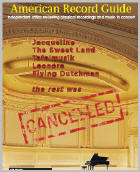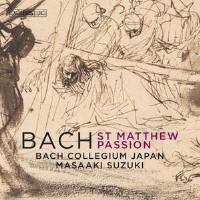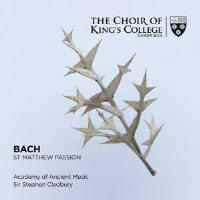Reviewer: William
J. Gatens
These two recordings of the
St Matthew Passion, both from 2019, have many elements in common but
also some significant differences. Both use period instruments and have
countertenors as alto soloists. Each is a characteristic instance of the
modern–day approach to baroque music. Masaaki Suzuki's choral singers are 26
mixed adults in two choirs of 13 voices. As far as I am concerned, they
represent the gold standard in baroque choral singing. Stephen Cleobury's
choir of King's College, Cambridge, is a traditional English choral
foundation with boys on the soprano line and countertenors on alto. The
booklet lists 28 singers. We cannot jump to the conclusion that they produce
the men–and–boys sound Bach would have expected in his sacred vocal music.
We can never know exactly how Bach's singers sounded, but present–day German
choirboys sound very different from their English counterparts. As far as I
know, the countertenor voice was never cultivated in Germany. Alto parts
would most likely have been sung by older boys whose voices were on the
verge of changing. Then there is the whole controversy as to whether this
music was sung by one voice to a part. Both choirs are excellent, but I find
that Bach Collegium Japan has the edge in clarity, precision, and
intonation. It is well known that Bach wrote the St Matthew Passion
for two choirs and two orchestras plus a ripieno chorale choir that sings in
the opening and probably the closing movements of Part I. The aria soloists
are from the choirs, and Bach specifically designates which choir
contributes a given soloist. Suzuki preserves this aspect of the scoring,
and a glance at the heading of this review shows four pairs of soloists
apart from the Evangelist. Christian Immler does double duty as Bass 1
soloist and Jesus. Cleobury, on the other hand, has a conventional quartet
of soloists who are not part of either choir.
It is pointless to attempt the
St Matthew Passion without a first–rate Evangelist. The part
consists entirely of recitative, but it is demanding and lies high in the
tenor voice. Both of these recordings have excellent Evangelists with clear
and rounded tone that seems especially designed to deliver this narrative
with engaging conviction. Neither Benjamin Bruns for Suzuki nor James
Gilchrist for Cleobury show any strain on the higher reaches of their part.
The question inevitably arises of how theatrical this part is meant to be.
There is, of course, a dramatic component in this work, especially in the
dialog that runs through it, but it is not an opera. It is an integral part
of a worship service. (The Leipzig authorities advised Bach against writing
operatic church music.) The dialog is embedded in the Evangelist's narrative
and interrupted with contemplative accompanied recitatives, arias, and
chorales. The Evangelist is essentially a storyteller, and the expressive
telling of a story is quite different from acting a part. At some point,
vehement expression can cross the line into frantic histrionics. I think
both of these Evangelists cross it from time to time, Bruns more often than
Gilchrist. This is Suzuki's second recording of the St Matthew Passion
with Bach Collegium Japan. The first was made in 1999.
The only soloist who appears in both is tenor Makoto Sakurada. Bass Chiyuki
Urano was a soloist in 1999. Here he is listed with the choir but has no
solo assignments. The earlier recording used a quartet of soloists who were
not part of the choirs. Some of the minor roles were sung by choir members.
Comparing the two recordings, I would not say that Suzuki now has a
drastically different conception of the work after 20 years. One notable
difference is in his treatment of the chorales. I have rather strong
feelings on this subject. (See my review of the St John Passion,
above.) In 1999 Suzuki treated the chorales with a formal solemnity
befitting the voice of the Church, and that is how I think they should be
treated. In the new recording the delivery is far more subjective, with
varying tempos, performance styles, and imposed dynamic shadings that tend
to undermine their function as the sturdy pillars supporting the narrative
and contemplative aspects of the other movements. The sound of the new
recording, making use of SACD technology, is warmer and clearer than 1999,
and I find the balance between solo voices and instruments much improved.
Perhaps the most notable difference between this and the earlier recording
is the organ used for continuo. As Suzuki points out in a brief essay in the
booklet, this function would have been performed in Bach's day by the large
church organ in the west gallery. Most modern performances rely on feeble–
toned cabinet organs. Suzuki claims that the ideal continuo organ for his
purposes would have a substantial though not necessarily very loud
foundation tone, the capacity to play at 16–foot pitch, a tuning adjustment
for differences in temperature, and the ability to play at historical pitch
levels and tunings. Finally, it needs to be movable. Organ builder Marc
Garnier has built such an instrument, heard on this recording as the
continuo organ for choir and orchestra 1 and the Evangelist's recitatives.
It produces a solid and supportive tone in a variety of colors but is not
annoyingly obtrusive. Choir and orchestra 2 are supported by a combination
of a cabinet organ and harpsichord. There is no such thing as a perfect
performance of as extensive and complex a work as the St Matthew Passion.
Suzuki is sometimes given to tempos that I find too fast for the expressive
solemnity of the subject matter. On the other hand, he often hits the right
balance between flow and contemplation. The opening chorus of Part I is a
prime instance where I believe he absolutely nails the tempo with a steady
and solemn pulse that can hardly fail to touch the heart of the attentive
listener. He assembles an impressive roster of soloists, and while some
faults can be found here and there, it would be churlish to dwell on them.
Sir Stephen Cleobury (1948–2019) was the director of music at King's College
from 1982 to 2019. During his tenure, it became the custom to present one of
the Bach Passions each year. This recording was made in April of 2019. (Cleobury
died in November.) It is apparently a concert recording in the college
chapel. The date is given as April 14–16, so I assume that what we have is a
compilation from more than one concert performance. At the risk of speaking
ill of the recently deceased, I cannot say that I find Cleobury's
performance particularly moving. I have made similar observations of other
recordings by him, especially the St John Passion (King's 18; M/A
2018). There is no question that the performances are technically polished
and impressive, but somehow they do not seem to get very far beneath the
surface. Perhaps it is British reserve, or as I speculated in my review of
the St John Passion, it all seems too much like business as usual for
a choir and director accustomed to the daily routine of an Anglican choral
foundation. Of the two performances under review, Suzuki's is by far the
more subtle, with nuances of tempo and phrasing that impart a vital and
engaging elasticity to the music. He can hardly be described as
self–indulgently sentimental, but he is more likely than Cleobury to touch
the heart of the listener. In the opening chorus, for instance, Cleobury's
tempo is quick enough to make the music sound a bit perfunctory compared
with Suzuki. Cleobury's soloists are very good, but not unqualifiedly so.
James Gilchrist is outstanding as the Evangelist. Matthew Rose as Jesus is
less impressive. His slightly gruff delivery sometimes seems more
appropriate for Wotan than Jesus. In contrast, Christian Immler for Suzuki
never fails to project the essential dignity and majesty of the part. There
is one remarkable moment in the Last Supper segment of Part I that
encapsulates the sensitivity of his performance. At the text "Wahrlich, ich
sage euch..." (Truly, I say to you: one among you will betray me), Immler
uncannily conveys the uneasiness of the moment without ever compromising the
dignity of the speaker. Among Cleobury's aria soloists, Sophie Bevan is
impressive as a light–toned early music soprano. Countertenor David Allsopp
has a remarkably even tone that many countertenors lack, and he never sounds
fruity, as Suzuki's Damien Guillon and Clint van der Linde sometimes do.
Tenor Mark Le Brocq produces a very fine tone, but he seems strained on the
upper notes of his part, making it sound more labored than it ought to. Bass
William Gaunt has a more majestic tone than Matthew Rose. He discharges
himself impressively in most of the bass solos, but I was disappointed with
his final offering, the recitative 'Am Abend' and the aria 'Mach dich, Mein
Herze Rein'. As a contemplation of the burial of Jesus, these numbers should
be perhaps the most heartbreaking in the entire work, but here they are not.
Apart from that, the soloist's voice sounds too distant—possibly a hazard of
concert recording. Finally, Cleobury's tempo in the concluding chorus makes
it sound more like a slow waltz than a solemn tombeau.
Fermer la fenêtre/Close window
|





